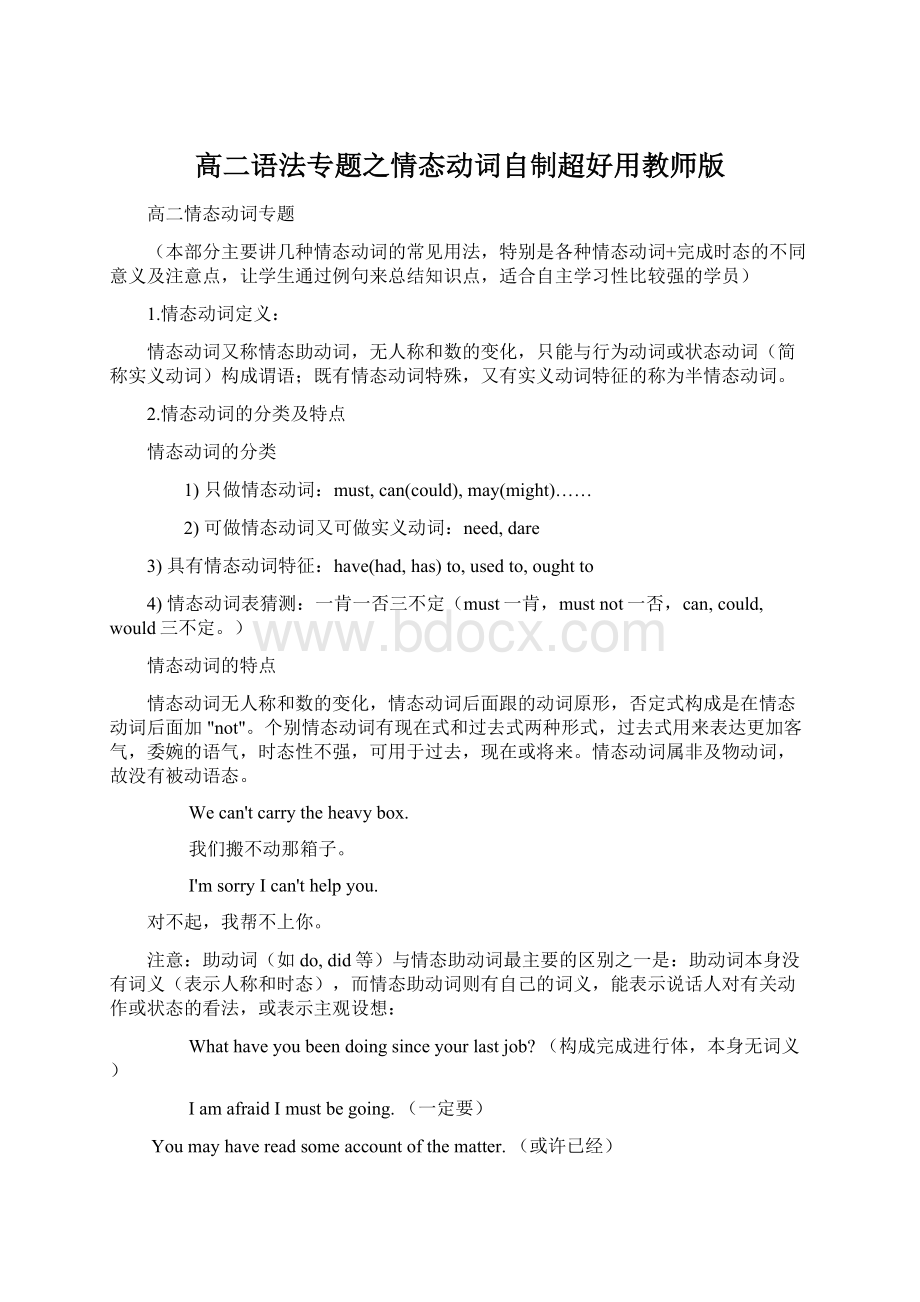高二语法专题之情态动词自制超好用教师版.docx
《高二语法专题之情态动词自制超好用教师版.docx》由会员分享,可在线阅读,更多相关《高二语法专题之情态动词自制超好用教师版.docx(27页珍藏版)》请在冰豆网上搜索。

高二语法专题之情态动词自制超好用教师版
高二情态动词专题
(本部分主要讲几种情态动词的常见用法,特别是各种情态动词+完成时态的不同意义及注意点,让学生通过例句来总结知识点,适合自主学习性比较强的学员)
1.情态动词定义:
情态动词又称情态助动词,无人称和数的变化,只能与行为动词或状态动词(简称实义动词)构成谓语;既有情态动词特殊,又有实义动词特征的称为半情态动词。
2.情态动词的分类及特点
情态动词的分类
1)只做情态动词:
must,can(could),may(might)……
2)可做情态动词又可做实义动词:
need,dare
3)具有情态动词特征:
have(had,has)to,usedto,oughtto
4)情态动词表猜测:
一肯一否三不定(must一肯,mustnot一否,can,could,would三不定。
)
情态动词的特点
情态动词无人称和数的变化,情态动词后面跟的动词原形,否定式构成是在情态动词后面加"not"。
个别情态动词有现在式和过去式两种形式,过去式用来表达更加客气,委婉的语气,时态性不强,可用于过去,现在或将来。
情态动词属非及物动词,故没有被动语态。
Wecan'tcarrytheheavybox.
我们搬不动那箱子。
I'msorryIcan'thelpyou.
对不起,我帮不上你。
注意:
助动词(如do,did等)与情态助动词最主要的区别之一是:
助动词本身没有词义(表示人称和时态),而情态助动词则有自己的词义,能表示说话人对有关动作或状态的看法,或表示主观设想:
Whathaveyoubeendoingsinceyourlastjob?
(构成完成进行体,本身无词义)
IamafraidImustbegoing.(一定要)
Youmayhavereadsomeaccountofthematter.(或许已经)
NO.1can&could
1.用法
1)表示能力,指有能力做某事,意为“能够”
(1)--“Idon’tthinkMikecantype.”
--“Yes,hecan.”
(2)IcanspeakfluentEnglishnow,butIcouldn’tlastyear.
2)表示请求和允许。
表示请求,口语中常用could代替can,使语气更委婉;意为“可否、可以”。
(1)Canweturntheairconditioneron?
(2)Couldyouhavehercallmebackwhenshegetshome,please?
3)在肯定句中,表示理论性的可能性;译为“有时候会…”。
要表达具体某事实际发生的可能性时,不用can,需用could,may,might。
(1)I’mconfidentthatasolutioncanbefound.
(2)Itwillbesunnyinthedaytime,butitcouldraintonight.(实际可能性)
4)用在否定、疑问或感叹句中,意为“可能”。
(1)Itcan’tbeeasycaringforamanandachildwhoarenotyourown.
(2)Canthemanovertherebeourheadmaster?
5)表示推测,用在否定句、疑问句和感叹句中,表示惊异、怀疑、不相信等态度,意为“可能,能够”
(1)Canthisbeanexcusefornotgivingthemhelp?
(2)Thiscan’tbetrue.
注意:
1)could用来表示请求时,语气委婉,主要用于疑问句,不能用于肯定句,答语应用can(即:
could不能用于现在时态的简略答语中)。
如:
——CouldIuseyourdictionary?
——Yes,youcan.(否定回答可用:
No,I’mafraidnot.)
Mary____beinParis,Isawherintownonlyafewminutesago.
A.mustn't B.shouldn't C.can't D.maynot
Key:
C
2)can和beableto辨析
can(could)和beableto都可以表示能力,意思上没有区别。
但can只有现在式和过去式,而beableto则有更多的形式。
如:
I’vealwayswantedtobeabletospeakfluentEnglish.
Thosebagslookreallyheavy.Areyousureyou’llbeabletocarrythemonyourown?
但是,表示在过去某时的某一场合经过一番努力,终于做成了某事,通常不用could,而用was/wereableto来表示。
这时,was/wereableto相当于managedtodo或succeedindoing。
如:
Aftertheaccidentitwasalongtimebeforeshewasabletowalkagain.
Thefirewasverybig,butmostpeoplewereabletoescapefromthebuilding.
另外,表示“有能力克服困难做成某事”,还可用managetodo或succeedindoing。
如:
Doyouthinkshe’llmanagetogetavisa?
Thearmysucceededindefeatingtheirenemy.
1)Thefirespreadthroughthehotelveryquickly,buteveryone____getout.
A.hadto B.would C.could D.wasableto
2)-Willyoustayforlunch?
-Sorry,_____.Mybrotheriscomingtoseeme.
A.Imustn't B.Ican't C.Ineedn't D.Iwon't
Keys:
1)D2)B
NO.2may&might
1.用法
1)表示允许、许可。
否定回答一般用mustnot/mustn’t,表示“禁止、阻止”之意,但也可以用hadbetternot(最好别)或maynot(不可以),语气较为委婉。
(1)MayIcomeinandwait?
(2)—MayIsmokehere?
—No,youmustn’t.(或No,you’dbetternot.)
2)在表示请求、允许时,might比may语气更委婉些。
用MayI征询对方许可在文体上比较正式,在口气上比较客气,在日常用语中,用CanI征询对方意见更为常见。
(1)MightIborrowyourpen?
(2)IwonderifImightspeaktoyourson.
3)表示可能性的推测,通常用在肯定句和否定句中,含有“或许”“大概”“可能”之意;用might代替may时,则语气显得更加不肯定。
(1)Itmayrainthisafternoon.
(2)Shemightcometojoinusthisafternoon.
4)may用于祈使句表示祝愿、但愿
(1)Mayyousucceed.
(2)Longmayhelive!
愿他能持续住下去。
(3)Maysherestinpeace.愿她安息。
5)用于表让步的状语从句中
(1)Tryashemight,hecouldnotgetoutthedifficult.
(2)Comewhatmay,Iwillneverdesertyou.
6)might常用于表示委婉的请求或轻微的责备。
(1)Youmightpostthisletterformeifyouaregoingnearapostbox.
(2)Youmighthaveletmeknowbefore!
NO.2must&haveto
1.must用法
1)用于第一人称表示说话人有义务,有必要做某事;用于第二、三人称表示命令或要求某人做某事。
(1)Youmustcometoschoolontime.
(2)Everybodymustobeythelaw.
2)回答带有must的问句时,否定回答常用needn’t或don’thaveto,表示“不必”,而不用mustn’t
(1)—MustIcomebackbeforeten?
—Yes,youmust.(No,youneedn’t)
3)表推断、预期或人以避免,意为“肯定是、必然会”。
(1)Itmustbemymother.
(2)Youmustbehungryafterawalk.
4)表示“偏要、硬要”:
用于第二人称,意指不耐烦或令人不愉快的事;用于其它人称,表示主语固执或不巧,意为“偏偏”
(1)Ifyoumustsmoke,youcangotothesmokingsection.
(2)Whymustyoubuythatcar?
5)must的否定有如下3种形式,用于不同场合:
1)表示“合理的推断和可能性”时,否定意为“不可能”;2)表示“义务和必要”时,否定意为“不必”;3)表示“禁止和批评”时,否定意为“决不能”。
(1)–Itmustbeeleveno’clocknow.–Itcannotbeeleveno’clocknow.
(2)Youmustn’tparkyourcarhere.
6)可作名词,表示“必须有的东西(做的事)”
(1)Warmclothesareamustinthemountains.
(2)Don’tmisshislatestplay;it’samust.
2.haveto用法
1)“必须,不得不”,意义与must相近。
但must表示的是说话人的主观看法,而haveto则往往强调客观需要。
(1)Thefilmisnotinteresting.Ireallymustgonow.
2)must只有一种形式,即现在式与过去式都是一种形式,而haveto则涉及各种人称、时态等方面的变化形式。
(1)IhadtoworkhardwhenIwasyourage.
(2)Iwillhavetolearnhowtouseacomputer.
3)两者的否定意义不同,mustn’t表示“禁止,不许”,don’thaveto表示不必。
(1)Youmustn’tgothere.
(2)Youdon’thavetogothere.
NO.3shall&should
1.shall用法
1)用于第一、二、三人称构成的疑问句,表示征求对方意见或请求指示,表示“商量斟酌”
(1)ShallIopenthewindow?
(2)Shallwesay6o’clock,then?
2)用于第二、三人称陈述句中,表示说话人给对方的命令、警告、允诺或威胁。
(1)Don’tworry,youshallgettheanswerthisafternoon.(允诺)
(2)Heshallbesorryforitoneday,Itellyou.(警告)
(3)YoushalldoasIsay.(命令)
(4)Ifyouchildrendon’tdoasItellyou,youshallnotgototheparty.(威胁)
3)在法律、条约、规章等文件中,无论主语人称如何,一律用shall,表示义务、规定、预言等。
(1)Houseownersshallkeeptheirgardensinaneatandordinarystate.(义务)
(2)Eachcitizenshallcarryhisidentificationcardwhentraveling.(规定)
(3)Deathiscertaintoall;allshalldie.(预言)
2.should用法
1)表示劝告或建议或命令,同义词为“oughtto”;表示义务,意指应该做,且有一种道义上的责任。
(1)WhatshouldIdo?
(2)ShouldItrusthim?
2)表示推测,用在肯定句中,对现在的情况或可能发生的事的主观推测或期待。
意为“想必,大概,或许”
(1)Itshouldbeanicedaytomorrow.
(2)TryphoningRobert,heshouldbehomenow.
3)还可以用在if引导的条件句中,表示一件事听起来可能性很小,但也不是完全不可能,相当于“万一”的意思。
从句谓语用should+动词原形构成,主句一定用虚拟语气
(1)AskTomtoringmeupifyoushouldseehim.(你万一见到汤姆,请让他给我打个电话)
(2)ShouldIbefreetomorrow,I’llcome.(万一我明天有时间,我就过来)
4)用于疑问句或感叹句中,表示意外、惊异的情绪,意为“竟会、竟然”;在疑问句中与why,what,how,who连用,表示不合理,难以相信或不应该之事;类似结构还有“I’msurprised;Itworriesme;It’sapity;Youcan’timagine…”
(1)WhyshouldanyonewanttomarryTony?
(2)Don’taskme.HowshouldIknow?
例题
1)Yourbrotherseldomcomestoseeyou,____?
A.doeshe B.doesn'the C.willhe D.isn'the
2)It'safineday.Let'sgofishing,____?
A.won'twe B.willwe C.don'twe D.shallwe
Keys:
1)A2)D
NO.4will&would
1.Will用法
1)用于表示意志、愿望和决心。
will指现在,would指过去。
(1)Heisthemanwhowillgohisownway.(他是个自行其是的人。
)
2)表示请求、建议等,用would比用will委婉、客气
(2)Willyoupleasetakeamessageforhim?
3)表示习惯或倾向,意为“总是,惯于”多用于第三人称。
will至现在,would指过去。
(1)Fishwilldiewithoutwater.
(2)Peoplewilltalk.(人们总会说闲话。
)
4)表示推测,意为“很可能,大概”。
will表示推测比should把握大,比must把握小。
(1)Thesethingswillhappen.
(2)Thatwillbethemessengerringing.
5)表示自然规律(指现在,有时可用现在时)。
(1)Oilandwaterwillnotmix.
6)用于对一个令人厌烦的坏习惯或对无生命物体进行批评(若仅陈述事实,不含厌烦情绪时,也可用现在时)。
(1)WhateverIdo,mycarwon’tstartfirsttimeoncoldmornings.
7)用在if条件句中:
1)表示意志,意为“insiston”;2)表示有礼貌的请求或劝阻,意为“bewillingto”;3)表示对将来行为的预示。
(1)Ifyouwillgoout/insistongoingoutwithoutacoat,youwillcatchacold.
(2)Ifyouwillmakeanothertry,Ishalldoeverythingtohelpyou.
(3)Ifthewaterwillriseabovethislevel,thenwemustwarneverybodyintheneighbourhood.
8)用于否定句中,意为“不肯”、“不乐意”,表示“坚决地拒绝”
(1)Iwon’tlistentoyournonsense.
(2)NomatterwhatIsaid,hewouldn’tlistentome.
2.would用法
1)可表示过去反复发生的动作或某种倾向。
比usedto正式,且没有“现已无此习惯”的含义,常与everyday,often,frequently等连用。
(1)Duringthevocationhewouldvisitmeeveryweek.
(2)Inthosedaystheoldmanwouldgetupveryearlyinthemorningandgoforawalkinthefields.
例题
1)Don'tsmokeinthemeetingroom,___you?
A.doyouB.willyou C.canyou D.couldyou
2)-It'smybirthdaytomorrow.Don'tforgettocometomyparty.
-_____.
A.Idon't B.Iwon't C.Ican't D.Ihaven't
Keys:
1)B2)B
注意:
would与usedto辨析
would可用来表示过去反复出现的动作,但不能表示过去存在的状态,所以我们不能说:
“shewouldbeaquietgirl.”另外,would强调过去某种特定情况下的活动,是完全过去的事情,同现在没有联系。
而usedto则着眼于过去和现在的对比,隐含现在已不存在,动作或状态都可表示。
Would可以表示不规则的习惯,usedto则不可。
如:
Heusedtobeanaughtyboyandcausetrouble.
Iusedtogetupatsixinthemorning.
Sometimesshewouldtakeawalkintheneighboringwoods.
Inthosedays,wheneverIhaddifficulties,IwouldgotoMr.Chenforhelp.
NO.5need&dare
1.Need用法
1)用于表示“需要,必要”之意。
做情态动词时,仅用于否定句和疑问句,只有现在时,过去式要用needn'thave,疑问式用need+人称?
否定式用neednot(即needn't)
(1)Youneedn'thavehurried.(=Itwasnotnecessaryforyoutohurry,butyoudid).
2)做实义动词时,其变化与一般的实义动词相同,后接带to的不定式(needdoing=needtobedone),过去式用needed、didyouneed?
和didn'tneed,肯定式用needs/needed/need,疑问式用do、does、did提问,否定式要在前面加don't、doesn't、didn't
(1)Ajoblikenursingneedspatienceandunderstanding.(need+名词,needunderstanding=needtobeunderstood,需要被理解)
2.dare用法
1)用于表示“敢于”之意。
做情态动词,没有人称和数的变化,主要用于否定句、疑问句和条件状语从句中
(1)Hedaren’tadmitthis.
2)用作实义动词时,其变化与一般的实义动词相同。
在肯定句中,dare后接带to的不定式;否定句中,dare后既可接带to的不定式,也可接不带to的不定式。
(1)Onlyafewjournalistsdaredtocoverthestory.
(2)Hedoesn’tdare(to)gotherealone.
例题
1)Idon'tknowwhetherhe____try.
A.dare B.needs C.wants D.isallowed
2)-ShallItellJohnaboutit?
-No,you___.I'vetoldhimalready.
A.needn't B.wouldn't C.mustn't D.shouldn't
3)It'safineday.You____takearaincoatwithyou.
A.can't B.mustn't C.needn't D.maynot
Keys:
1)A2)A3)C
注意
didn’tneedtodo,意为“不必做某事”,如:
Wedidn’tneedtotakewarmsweaters,astheweatherwassogood.
needn’thavedone,意为“本不必做但实际上已经做了”,如:
Weneedn’thavetakenwarmsweaters.Wecouldhaveusedthespaceinourluggageformorebooks!
NO.6oughtto
1)表示“应该”之意
(1)—OughtIgonow?
—Yes,